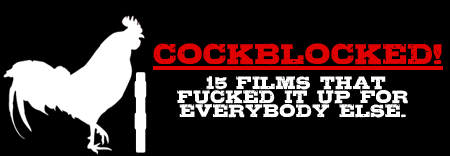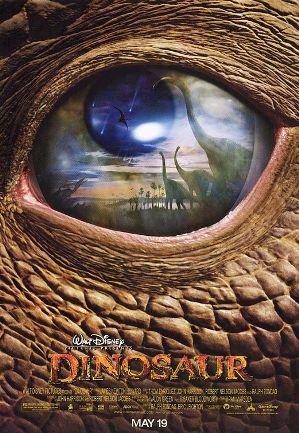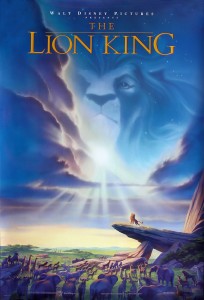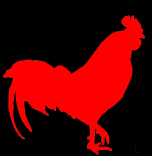
There’s a long history in Hollywood of shelved projects, abandoned franchise dreams, stalled careers, and entire genres that lost favor or profitability. 9 times out 10 these problems and failures are the result of a myriad of complex issues and contributing factors. Sometimes though… Sometimes you can pretty much pin everything on one film that fucked it up for everyone. Whether it’s a movie that killed a rival project, destroyed a filmmaker’s career, squashed some brilliant idea, or took the shine off of an entire genre, this CHUD List will catalog the films that were just total, unapologetic Cockblocks.
———-
———

Day 6 (Walt Disney’s Dinosaur)
Damon Houx (Email • Twitter)
———-
 THE COCK: The Walt Disney animation team. After re-emerging after years in the wasteland, 1989’s The Little Mermaid brought to the fore everything people loved about Disney animation for a new generation. Their follow up was The Rescuers Down Under, which showcases how slow animation and studio systems are. It was followed by Beauty and the Beast, which was nominated for best picture and then came Aladdin and The Lion King – both of which were blockbusters, and all four of which are family classics. Their success led Disney into being an animation factory, hoping to push out an animated title a year. And so next came Pocahontas, The Hunchback of Notre Dame, Hercules, and Mulan. None of these next set of films were as well received as The Lion King, but they were never disastrous (though Hercules couldn’t make it to $100 Million at the box office).
THE COCK: The Walt Disney animation team. After re-emerging after years in the wasteland, 1989’s The Little Mermaid brought to the fore everything people loved about Disney animation for a new generation. Their follow up was The Rescuers Down Under, which showcases how slow animation and studio systems are. It was followed by Beauty and the Beast, which was nominated for best picture and then came Aladdin and The Lion King – both of which were blockbusters, and all four of which are family classics. Their success led Disney into being an animation factory, hoping to push out an animated title a year. And so next came Pocahontas, The Hunchback of Notre Dame, Hercules, and Mulan. None of these next set of films were as well received as The Lion King, but they were never disastrous (though Hercules couldn’t make it to $100 Million at the box office).
In 1999 they had Tarzan, which did $171 Million and was one of the biggest hits of the summer. Jeffery Katzenberg had left Disney by that point to create Dreamworks Animation, though by the end of the century, they were no great threat: Prince of Egypt did okay – it limped to its $100 Million at the Box office through its holiday release. Walt Disney was still the best name in animation. Walt Disney were the kings of 20th century animation.
Somehow over the next ten years, their animation department was ruined, and the studio flopped about trying to do CGI and traditional animation, while never recapturing the magic. There had to be something that brought them down, and essentially made Pixar – who was once distributed by Disney – and John Lasseter the head honcho. Lasseter’s career started as a Disney animator, how did the pupil become the master?
THE BLOCK: Dinosaur (2000)
Much like the asteroid that supposedly killed off the dinosaurs (or the appearance of Jesus, if I understand Creation Science correctly), Dinosaur was the asteroid that brought down Disney’s once powerful animation squad.

"Do you remember this movie?" "No, do you?"
I don’t know if it was hubris that led Walt Disney to pursue computer animation, as it was the way of the world, and since Beauty and the Beast animated films had incorporated digital trickery to help animate films, so perhaps trying CG on their own was a logical step. Originally the film was conceived as being done with no dialogue and was meant to be somewhat experimental; the more they played with it, the more they realized that they were better off doing it conventionally. Disney gave it a great send off: They were very proud of their effort, and had it set for a summer launch on the Star Wars weekend. I don’t think they saw it coming, perhaps they were so wowed with their ability to do CG animation that they didn’t realize the film was a turd.

"Hey, it's a cute... something or other."
But what this also did was show that the Walt Disney studio had an Achille’s heel. Long seen as the standard-bearer for animated films, here they proved themselves to be unable to compete with the new generation. The film didn’t have that Disney magic, and though it wasn’t as pathetic as hair plugs, it was definitely a case where they couldn’t adapt to the new way. I think this was also the breaking point for a lot of parents – that though is harder to track – because the Walt Disney label used to mean something magical. And though there had been a number of films like Hunchback that weren’t up to snuff, at least they were following the formula. Dinosaur – coupled with the more Warner Brothers-like Emperor’s New Groove – showed that Walt Disney was no longer making Walt Disney films, and in doing so ruined the most important asset the company had. Dinosaur was New Coke, but there was no going back as the Coke Classics of films like The Princess and The Frog came too late.

"I don't know about you guys, but I want to fuck everything on this poster."
Verdict: Bullet Dodged.
The Alternate Universe:
&
Like / Share it on Facebook (above or below) if you think it’s great!
